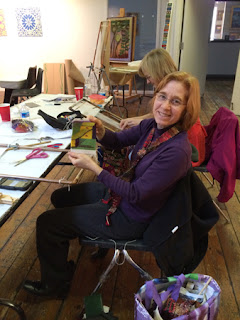Last weekend I spent three days with a group of thirteen eager tapestry weavers at Artspace in Raleigh, NC. I'd been asked there to teach a workshop during the time the American Tapestry Alliance juried small format international 4 exhibit "Honoring Tradition, Inspiring Innovation" was on exhibit at Artspace. What a treat to be able to have beautiful tapestries done in almost any style and technique imaginable for reference during the class!
First, here are a few overview photos of almost all of the walls holding the exhibit:
And then a few shots with class members taking a close look:
The exhibit was well presented in the open space of the gallery. The thoughtful placement of the small tapestries gave enough wall area around each so that it held its own and let viewers contemplate the intricacies of the work.
A catalog of the exhibit is available from ATA. There's nothing that replaces a face-to-face (or face-to-weaving) experience but a catalog is the second best thing.
Now... about the workshop. This was billed as a beginning workshop but open to all levels of tapestry experience. Seems everyone in the class had weaving experience, whether on floor looms or tapestry, so I covered basics pretty quickly in the first day.
I suggested for the workshop a 4" width for the small tapestry on either on a frame loom borrowed from me (from my stock of Archie Brennan style looms) or on their own loom. I brought the warp, a 12/12 cotton seine twine that I'd pre-wound into 40 yard balls; that was put onto the loom at a sett of 8 epi.
I brought along a suitcase filled with an assortment of Vevgarn (from Norsk Fjord Fiber), a few cones of ALV (from Kathe Todd-Hooker at Fine Fiber Press and Studio), and several spools of Mora (from Glimakra USA). I also had several different weights of warp so they could compare the sizes and assemble a small reference card with snippets of a few inches of each warp.
I challenged them to select three different values to work with. We discussed the qualities of color in hue, intensity, and value and how intensity sometimes can fool our eye causing us to see a strong intensity as either lighter or darker than the value of it actually is. I suggested they try their smart phone to photograph the yarns in color and then in black and white to do a bit of value comparison (inspired by Sarah Swett's blog post here).
 |
| Yarn decisions |
 |
| Wonderful Mary Kircher, assistant and in charge of keeping it all running smoothly! |
And then on Monday afternoon the cutting off began!
All in all, I think everyone had a good time and learned some things. I know I did! Thanks, everyone at Artspace in Raleigh for arranging for the workshop. Especially, thank you, Mary Kircher for once more being a superior assistant (and wonderful hostess). And thank you to all of the workshop participants. I hope your future tapestry journeys will all be lovely.
Lesson learned--I won't be scheduling teaching or other activities out of town in January or February (or maybe even March!) in the future--too stressful on the psyche and body. At least that's the plan now. Next year?



























I think you are smart to consider the weather conditions. I wanted to take your class at JCCFS in 2015, but we never plan a trip to the folk school in the winter months as it might be impossible for us to get there from Texas.
ReplyDelete